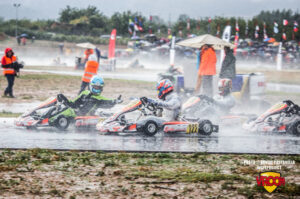
Welcome to the adrenaline-fueled world of karting! Karting is an exhilarating motorsport that gets your heart racing and your palms sweaty, but what happens when Mother Nature decides to join the race? Extreme weather conditions can add a whole new level of excitement and challenge to karting. In this blog post, we’ll explore the art of karting in extreme climates, where rain, heat, snow, and more can turn a typical race day into an unforgettable adventure.
Racing Raindrops: Wet Weather Karting
Rain-soaked tracks, slick tires, and the thrill of hydroplaning; racing in the rain adds an exciting twist to the karting experience. The grip on the track is precarious, and every turn becomes a daring dance with the elements. Drivers must adjust their technique to master the art of wet weather karting. So, how do you navigate a wet track?
Karting in the Rain
It’s all about the tires! Karting in wet conditions requires the use of special rain tires, designed to disperse water and provide better grip. Staying smooth on the steering wheel and practicing controlled throttle management are crucial.
Techniques for Success
In the rain, the racing line becomes slippery. Drivers need to choose alternative lines with better traction, and braking should be gentle to avoid skidding. It’s all about adapting to the ever-changing track conditions.
Sizzling on the Asphalt: Karting in Extreme Heat
Extreme heat can be as challenging as a sudden downpour. The sun beats down relentlessly on the asphalt, and the racing suits start to feel like ovens. Karting in extreme heat is a battle against both competition and dehydration.
Hydration is Key
In sweltering conditions, staying hydrated is crucial. Drivers need to take frequent water breaks to ensure they’re not overheating during races. It’s essential to find a balance between racing intensity and staying cool.
Tire Pressure and Setup
Extreme heat can affect tire pressure and the kart’s setup. Regularly check and adjust tire pressure to ensure optimal grip. Tweaking the kart’s setup to accommodate the hot conditions can significantly improve performance.
Braving the Chill: Karting in Cold Weather
Racing in extreme cold can feel like a test of endurance. Karting in frigid temperatures poses unique challenges. The tires struggle to grip the icy surface, and the engines need extra care to function at their best.
Heated Gear
Dressing appropriately is a must. Heated race suits, gloves, and visors can keep drivers warm during cold-weather races. Staying comfortable is essential to maintain focus and control.
Engine Warm-Up
In cold weather, it’s important to warm up the kart’s engine before hitting the track. Cold engines are less efficient, and warming them up ensures they run smoothly during the race.
Karting on Ice: Tackling Snowy Tracks
When winter hits, and snow blankets the racetrack, karting doesn’t stop. Instead, it transforms into a unique experience known as ice karting. Racing on icy tracks is like drifting through a winter wonderland, but it requires a different set of skills and equipment.
Ice Karting Basics
Ice karting involves specialized studded tires that provide traction on the slippery surface. Learning to control the kart’s drift is an essential skill, and it’s where the true thrill of ice karting lies.
The Right Clothing
In sub-zero temperatures, bundling up is essential. Warm layers, thermal socks, and balaclavas keep you snug as you navigate icy curves and power slides.
Adapting to Unpredictable Weather
Karting in extreme weather conditions is all about adaptability. Weather can be unpredictable, and it’s vital to monitor forecasts and be prepared for sudden changes. Extreme weather often leads to race cancellations, but that doesn’t mean the excitement stops.
Racing Culture in Extreme Conditions
Despite the challenges, karting in extreme weather can be a bonding experience. The shared struggle against the elements creates a unique camaraderie among karting enthusiasts. From swapping tips on tire pressure to sharing stories of epic races in the rain, the karting community thrives on overcoming adversity.
Safety First, Always
Safety should never be compromised, regardless of the weather. Racing in extreme conditions requires additional precautions. Drivers must ensure they have the proper safety gear and adhere to track regulations. If the weather becomes too severe, races may be postponed or canceled to protect everyone’s safety.
Conclusion
Karting in extreme weather conditions can be an adventure like no other. It tests your skills, resilience, and adaptability. Whether you’re sliding on ice or gripping wet asphalt, karting challenges you to become a better driver and experience the thrill of racing in conditions that most wouldn’t dare to tackle.
